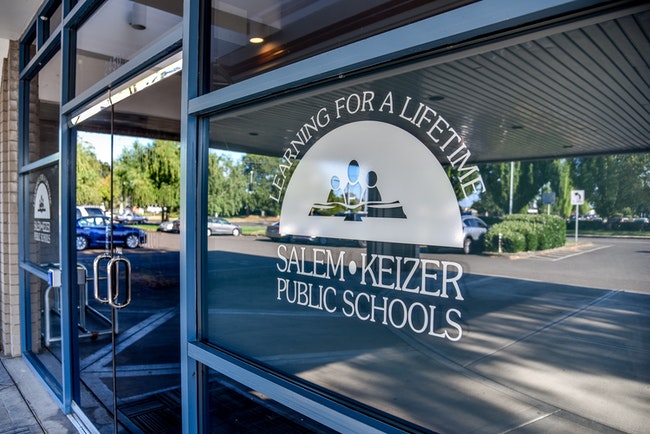Salem’s students won’t see bigger class sizes or lose services from counselors, social workers or other positions at their schools next year, but budget cuts mean teachers will have fewer mentors and other support workers at the district level.
Salem-Keizer Superintendent Christy Perry and incoming Superintendent Andrea Castañeda presented a draft $1.28 billion budget for Oregon’s second largest school district to the district’s budget committee Tuesday night. The budget covers the 2023-24 school year and would take effect when adopted by the school board.
READ: Salem-Keizer School District proposed 2023-24 budget
The district expects to receive slightly more money from the state than last year, but it won’t be enough to make up for rising costs in wages, utilities and materials, Superintendent Christy Perry said. To get by, she’s proposed cutting some district positions mentoring teachers and reducing funds to cover unexpected expenses.
The budget comes amid significant financial uncertainty for the district and ushers in an era of budget cuts which are expected to worsen in coming years as federal Covid funding to schools expires in 2024.
Mirroring national and state trends, district enrollment is declining, projected at 38,857 students next year. That’s about 700 fewer students than during the 2020-21 school year, Castañeda said.
The number of students who are not fluent English speakers is expected to increase to 8,175, up from 7,883 this school year. Those students typically require more support, and districts get higher funding per student from the state to meet their needs.
Despite the enrollment decline, the budget holds steady the number of teachers and other employees assigned to work at schools, though some jobs will be shifted between schools depending on enrollment. Perry said that’s important to keep class sizes lower and make sure students have the help they need.
Cuts to positions are being made at the district level, Perry said, primarily by reducing the number of instructional mentors who work for the district mentoring teachers. That change will cut six full-time jobs.
Employees whose positions are eliminated will be shifted to fill other vacant jobs, often moving from districtwide jobs to school-based ones and avoiding layoffs.
To avoid further cuts, the proposed budget also draws down the district’s contingency funds, which can be used to cover unexpected expenses or cost increases. Perry’s proposed budget puts contingency at 2.9% of the total budget, below the district’s financial policy of 5-7% contingency, and below the 4.6% in last year’s adopted budget.
Perry called the contingency level “dangerously low” during her presentation to the budget committee, but said she wanted to avoid eliminating more positions at a time when many students are still struggling to recover from Covid-related school closures.
The Oregon Legislature is still in session, which means the amount of the state school fund — which supplies the majority of the district’s budget — is unknown. Gov. Tina Kotek’s budget proposal set the fund at $9.9 billion, less than the $10.3 billion the Oregon Association of School Business Officials say is needed to keep current staffing and services.
Perry’s budget assumes a $9.9 billion state school fund. At that level, the district would receive about $6.9 million more from the state than for this school year, below what Perry said is less than the cost increases Salem-Keizer faces for materials and wages. Utility costs are budgeted to increase next year by about 10%, an $800,000 cost.
District leaders are also in negotiations with both employee unions, Salem-Keizer Education Association, which represents district teachers and licensed employees, and the Association of Salem-Keizer Education Support Professionals, which represents classroom aides, bus drivers, custodians and other support workers. Perry’s draft budget includes $14 million for wage increases, about 2.5%. The teacher union’s initial proposal April 6 sought a 15% cost of living increase.
The budget is less than the $1.36 billion approved for this school year, though the change in dollar amount is primarily due to the winding down of a school construction blitz voters approved in 2018. The final school improvement projects, most of them smaller in scale, will begin this year.
The district’s dual language program will continue to expand next year under the budget, adding programs at Auburn, Eyre, Hayesville, Kennedy, Scott, Lamb, Lee and Yoshikai elementary schools; Claggett Creek Middle School and McKay and McNary high schools. That expansion is possible because it doesn’t require new employees. Instead, existing teacher jobs will be changed to bilingual teachers who can instruct students in both English and Spanish.
It’s the first budget in several years where the district hasn’t rolled out new services or added positions intended to help struggling students.
Instead, district leaders said they’re focused on several core goals, including improving the share of students reading proficiently in elementary school, supporting career technical education programs, helping freshmen transition to high school, supporting safe and welcoming schools and improving attendance districtwide.
“We’ll be doing everything we can to focus on that and fund that in ways that are within our reach,” Castaneda said of the district’s goals.
How to get involved
The Salem-Keizer budget committee will meet next May 16 to discuss the proposed budget, hear an update from Perry and receive public comment. The committee consists of all seven elected school board directors, as well as seven appointed community members who serve three-year terms.
Lisa Harnisch, executive director of the Marion Polk Early Learning Hub, is chairing the committee this year.
Instructions for submitting comments will be posted on the district website closer to the meeting date.
On May 22, the committee will hear additional public comment and may vote to recommend the budget to the school board. If the committee doesn’t vote on the budget May 22, they may hold additional meetings May 23 and 24.
The school board will then vote on adopting the budget.
Contact reporter Rachel Alexander: [email protected] or 503-575-1241.
JUST THE FACTS, FOR SALEM – We report on your community with care and depth, fairness and accuracy. Get local news that matters to you. Subscribe to Salem Reporter. Click I want to subscribe!

Rachel Alexander is Salem Reporter’s managing editor. She joined Salem Reporter when it was founded in 2018 and covers city news, education, nonprofits and a little bit of everything else. She’s been a journalist in Oregon and Washington for a decade. Outside of work, she’s a skater and board member with Salem’s Cherry City Roller Derby and can often be found with her nose buried in a book.










